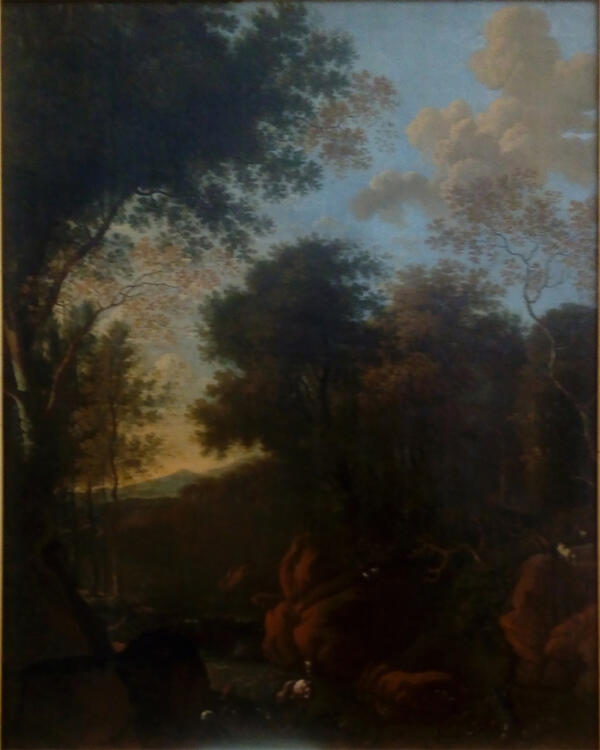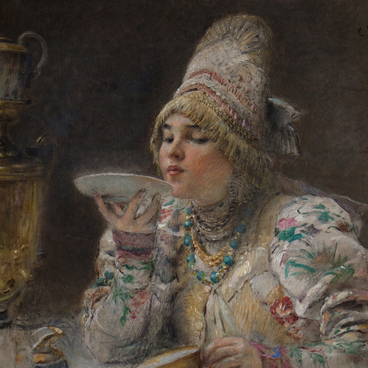The painting “Mountainous Landscape” by the Dutch artist Adriaen Jansz Ocker entered the Ulyanovsk Art Museum from the city of Simbirsk immediately after the Bolshevik revolution of 1917.
Landscape painting became a separate independent genre in the Dutch art of the Golden Age. The principles of the Dutch realistic landscape painting were formed during the first third of the 17th century under the influence of domestic political and economic changes. Holland gained freedom from Spain and became the main source of inspiration for its artists. Dutch painters abandoned figurative imagery and romanticized, ideal landscapes. Instead, they sought to capture the real beauty of the country, to recreate the image of their native land. They painted dunes and canals, houses and churches, rivers and fields. The artists captured the characteristic appearance of the surrounding area, created typical motifs of the national landscape. In addition, they sought to convey the atmosphere of the season, local area, temperature and humidity — this was how tonal painting developed.
There was a whole range of Dutch landscape paintings — the artists depicted the sea, the forest, urban, rural and seasonal scenes, the moonlight or fires at night. As artists developed linear and aerial perspective, chiaroscuro, proportions, general composition and relief, landscapes became a significant part of the composition. Later landscapes turned into the central subject in the works of Dutch painters.
Little is known about Adriaen Jansz Ocker, an artist from Amsterdam. Together with his contemporaries, including Johannes Lingelbach, Jan Asselijn, Nicolaes Berchem and Jan Dirksz Both, he was commissioned to create works in the fashionable Italian style. Adriaen Ocker’s paintings are very rare, but the artist’s style, his subtle approach to light and space, is recognizable in the painting “Mountainous Landscape.” The artist’s signed pictures had entered the collections of Johann Heinrich Wilhelm Tischbein and Count von Czernin in Oldenburg. It is very likely that many of Adriaen Ocker’s paintings had false attributions and have been preserved under different names.
Landscape painting became a separate independent genre in the Dutch art of the Golden Age. The principles of the Dutch realistic landscape painting were formed during the first third of the 17th century under the influence of domestic political and economic changes. Holland gained freedom from Spain and became the main source of inspiration for its artists. Dutch painters abandoned figurative imagery and romanticized, ideal landscapes. Instead, they sought to capture the real beauty of the country, to recreate the image of their native land. They painted dunes and canals, houses and churches, rivers and fields. The artists captured the characteristic appearance of the surrounding area, created typical motifs of the national landscape. In addition, they sought to convey the atmosphere of the season, local area, temperature and humidity — this was how tonal painting developed.
There was a whole range of Dutch landscape paintings — the artists depicted the sea, the forest, urban, rural and seasonal scenes, the moonlight or fires at night. As artists developed linear and aerial perspective, chiaroscuro, proportions, general composition and relief, landscapes became a significant part of the composition. Later landscapes turned into the central subject in the works of Dutch painters.
Little is known about Adriaen Jansz Ocker, an artist from Amsterdam. Together with his contemporaries, including Johannes Lingelbach, Jan Asselijn, Nicolaes Berchem and Jan Dirksz Both, he was commissioned to create works in the fashionable Italian style. Adriaen Ocker’s paintings are very rare, but the artist’s style, his subtle approach to light and space, is recognizable in the painting “Mountainous Landscape.” The artist’s signed pictures had entered the collections of Johann Heinrich Wilhelm Tischbein and Count von Czernin in Oldenburg. It is very likely that many of Adriaen Ocker’s paintings had false attributions and have been preserved under different names.



